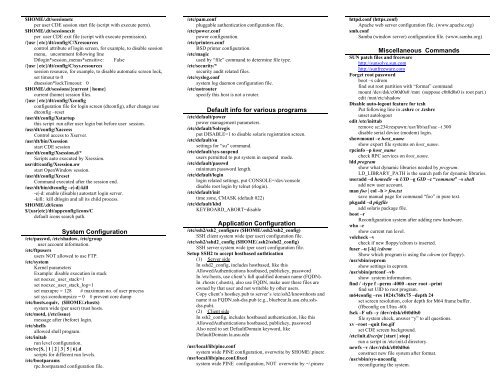Solaris Administrator's Quick Reference - Cheat Sheet
Solaris Administrator's Quick Reference - Cheat Sheet
Solaris Administrator's Quick Reference - Cheat Sheet
Create successful ePaper yourself
Turn your PDF publications into a flip-book with our unique Google optimized e-Paper software.
$HOME/.dt/sessionetc<br />
per user CDE session start file (script with execute perm).<br />
$HOME/.dt/sessionexit<br />
per user CDE exit file (script with execute permission).<br />
/{usr | etc}/dt/config/C/Xresources<br />
control attribute of login screen, for example, to disable session<br />
menu, uncomment following line<br />
Dtlogin*session_menus*sensitive: False<br />
/{usr | etc}/dt/config/C/sys.resources<br />
session resource, for example, to disable automatic screen lock,<br />
set timout to 0<br />
dtsession*lockTimeout: 0<br />
$HOME/.dt/sessions/{current | home}<br />
current (home) session files.<br />
/{usr | etc}/dt/config/Xconfig<br />
configuration file for login screen (dtconfig), after change use<br />
dtconfig –reset<br />
/usr/dt/config/Xstartup<br />
this script run after user login but before user session.<br />
/usr/dt/config/Xaccess<br />
Control access to Xserver.<br />
/usr/dt/bin/Xsession<br />
start CDE session<br />
/usr/dt/config/Xsession.d/*<br />
Scripts auto executed by Xsession.<br />
usr/dt/config/Xsession.ow<br />
start OpenWindow session.<br />
/usr/dt/config/Xreset<br />
Command executed after the session end.<br />
/usr/dt/bin/dtconfig –e|-d|-kill<br />
-e|-d: enable (disable) autostart login server.<br />
-kill: kill dtlogin and all its child process.<br />
$HOME/.dt/icons<br />
$/{usr|etc}/dt/appconfig/icons/C<br />
default icons search path.<br />
System Configuration<br />
/etc/passwd, /etc/shadow, /etc/group<br />
user account information.<br />
/etc/ftpusers<br />
users NOT allowed to use FTP.<br />
/etc/system<br />
Kernel parameters<br />
Example: disable execution in stack<br />
set noexec_user_stack=1<br />
set noexec_user_stack_log=1<br />
set maxuprc = 128 # maximum no. of user process<br />
set sys:coredumpsize = 0 # prevent core dump<br />
/etc/hosts.equiv, ($HOME/.rhosts)<br />
system wide (per user) trust hosts.<br />
/etc/motd, (/etc/issue)<br />
message after (before) login.<br />
/etc/shells<br />
allowed shell program.<br />
/etc/initab<br />
run level configuration.<br />
/etc/rc{S, | 1 | 2 | 3 | 5 | 6}.d<br />
scripts for different run levels.<br />
/etc/bootparams<br />
rpc.bootparamd configuration file.<br />
/etc/pam.conf<br />
pluggable authentication configuration file.<br />
/etc/power.conf<br />
power configuration.<br />
/etc/printers.conf<br />
BSD printer configuration.<br />
/etc/magic<br />
used by “file” command to determine file type.<br />
/etc/security/*<br />
security audit related files.<br />
/etc/syslog.conf<br />
system log daemon configuration file.<br />
/etc/notrouter<br />
specify this host is not a router.<br />
Default info for various programs<br />
/etc/default/power<br />
power management parameters.<br />
/etc/default/Solregis<br />
put DISABLE=1 to disable solaris registration screen.<br />
/etc/default/su<br />
settings for “su” command.<br />
/etc/default/sys-suspend<br />
users permitted to put system in suspend mode.<br />
/etc/default/passwd<br />
minimum password length.<br />
/etc/default/login<br />
login related settings, put CONSOLE=/dev/console<br />
disable root login by telnet (rlogin).<br />
/etc/default/init<br />
time zone, CMASK (default 022)<br />
/etc/default/kbd<br />
KEYBOARD_ABORT=disable<br />
Application Configuration<br />
/etc/ssh2/ssh2_configure ($HOME/.ssh2/ssh2_config)<br />
SSH client system wide (per user) configuration file.<br />
/etc/ssh2/sshd2_config ($HOME/.ssh2/sshd2_config)<br />
SSH server system wide (per user) configuration file.<br />
Setup SSH2 to accept hostbased authtication<br />
(1) Server side<br />
In sshd2_config, includes hostbased, like this<br />
AllowedAuthentications hostbased, publickey, password<br />
In /etc/hosts, use client’s full qualified domain name (FQDN).<br />
In .rhosts (.shosts), also use FQDN, make user these files are<br />
owned by that user and not writeble by other users.<br />
Copy client’s hostkey.pub to server’s /etc/ssh2/knownhosts and<br />
name it as FQDN.ssh-dss.pub (e.g., bluebear.la.asu.edu.sshdss.pub).<br />
(2) Client side<br />
In ssh2_config, includes hostbased authentication, like this<br />
AllowedAuthentications hostbased, publickey, password<br />
Also need to set DefaultDomain keyword, like<br />
DefaultDomain la.asu.edu<br />
/usr/local/lib/pine.conf<br />
system wide PINE configuration, overwrite by $HOME/.pinerc<br />
/usr/local/lib/pine.conf.fixed<br />
system wide PINE configuration, NOT overwrite by ~/.pinerc<br />
httpd.conf (https.conf)<br />
Apache web server configuration file. (www.apache.org)<br />
smb.conf<br />
Samba (window server) configuration file. (www.samba.org)<br />
Miscellaneous Commands<br />
SUN patch files and freeware<br />
http://sunsolve.sun.com<br />
http://sunfreeware.com<br />
Forget root password<br />
boot –s cdrom<br />
find out root partition with “format” command<br />
mount /dev/dsk/c0t0d0s0 /mnt (suppose c0t0d0s0 is root part.)<br />
edit /mnt/etc/shadow<br />
Disable auto-logout feature for tcsh<br />
Put following line in .cshrc or .tcshrc<br />
unset autologout<br />
edit /etc/inittab<br />
remove sc:234:respawn:/usr/lib/saf/sac –t 300<br />
disable serial device (modem) login.<br />
showmount –e host_name<br />
show export file systems on host_name.<br />
rpcinfo –p host_name<br />
check RPC services on host_name.<br />
ldd program<br />
show what dynamic libraries needed by program.<br />
LD_LIBRARY_PATH is the search path for dynamic libraries.<br />
useradd –d homedir –u UID –g GID –c “comment” –s shell<br />
add new user account.<br />
man foo | col –b > foo.txt<br />
save manual page for command “foo” in pure text.<br />
pkgadd –d pkgfile<br />
add solaris package file.<br />
boot –r<br />
Reconfiguration system after adding new hardware.<br />
who –r<br />
show current run level.<br />
volcheck –v<br />
check if new floppy/cdrom is inserted.<br />
fuser –u [-k] /cdrom<br />
Show which program is using the cdrom (or floppy).<br />
/usr/sbin/eeprom<br />
show settings in eeprom.<br />
/usr/sbin/prtconf –vb<br />
show system information.<br />
find / -type f –perm -4000 –user root –print<br />
find set UID to root program.<br />
m64config –res 1024x768x75 –depth 24<br />
set screen resolution, color depth for M64 frame buffer.<br />
(ffbconfig on Ultra -60)<br />
fsck –F ufs –y /dev/rdsk/c0t0d0s0<br />
file system check, answer “y” to all questions.<br />
xv –root –quit foo.gif<br />
set CDE screen background.<br />
/etc/init.d/script {start | stop}<br />
run a script in /etc/init.d directory.<br />
newfs –v /dev/rdsk/c0t0d0s6<br />
construct new file system after format.<br />
/usr/sbin/sys-unconfig<br />
reconfiguring the system.
















